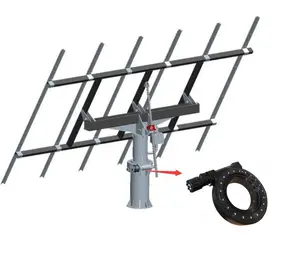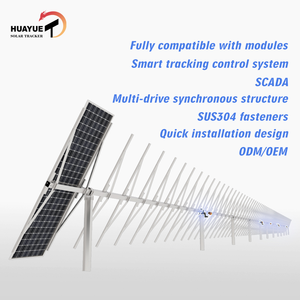
All categories
Featured selections
Trade Assurance
Buyer Central
Help Center
Get the app
Become a supplier

(1131 products available)







































Solar trackers are vital components for solar energy systems. They help in the constant orientation of photovoltaic panels or mirrors towards the sun. This enhances energy absorption all day long. Several types of solar trackers exist.
This constituent helps to provide several choices that will fit different conditions. Here are the common types of solar trackers according to movement.
Single-axis trackers are among the most popular used today. They have one axis of rotation. This allows PV panels to tilt and follow the sun's movement either horizontally or vertically.
Horizontal single-axis trackers run on a horizontal axis. They are often fitted on the horizontal roof types and flat rooftops. They increase sunlight capture by about 20% to 30% compared to fixed systems.
On the other hand, vertical single-axis trackers are mounted on vertical walls. They are ideal for buildings with a wall design structure. Their vertical design allows them to capture sunlight effectively, increasing energy output by up to 50%.
Finally, tilted single-axis trackers combine features of horizontal and vertical systems. They are mounted on tilted surfaces like sloped roofs or hilly terrains.
Aside from being popular, single-axis trackers are also cost-effective. They are less complex than multi-axis systems. Moreover, they require simpler installation and maintenance processes, reducing overall costs.
Dual-axis trackers are often preferred. They have two axes of rotation. These systems then follow the sun's path both vertically and horizontally throughout the day.
This capability allows dual-axis trackers to capture the maximum amount of solar energy at all times. As a result, they provide up to 40% more energy than fixed installations.
Unlike trackers, fixed-tilt systems are stationary. They are installed at a certain angle optimized for solar exposure. This makes it possible for the panels to absorb maximum sunlight all year round.
Though not as flexible, fixed-tilt solar trackers are cost-effective. They don't have moving parts like actuators and motors. This greatly reduces the installation cost and maintenance requirements.
Various factors influence the price of solar trackers. These factors include their type, degree of tracking, and setup complexity. The kind of solar tracker also affects its price. For instance, single-axis trackers are simpler than dual-axis trackers.
This simplicity makes them cheaper. But dual-axis trackers track the sun in two directions. Their added complexity increases their costs further. How complex a tracker is affects its cost. More complex systems require more time for their installation and maintenance.
Solar tracking systems are usually employed together with concentrated solar power (CSP) systems. The CSP systems work by using mirrors to reflect sunlight onto a small area.
This sunlight concentration generates more heat. The more heat absorbed by the CSP the better the solar energy generation capacity. Many of these solar trackers are installed either on rooftops or in open areas.
Rooftop solar trackers are more expensive than ground-mounted ones. This is because of the installation complexity. Other factors that influence solar tracker prices include geographical area, incentives, and weather.
Paying attention to the specifications and maintenance requirements of solar trackers is important. It ensures optimal performance and longevity. Trackers are usually categorized based on the number of axes they move along.
For instance, single-axis trackers are usually designed to rotate on one horizontal or vertical axis. They are meant to increase energy capture by around 25% compared to fixed systems. It is also worth noting that dual-axis trackers offer more precise tracking.
These systems usually allow the tracker to tilt in two directions. As a result, they can track the sun all day every season. Their added functionality captures about 40% more energy than static installations.
The size of the trackers will depend on the solar installation project. Larger projects often require more massive single-axis trackers. The huge ones are preferred because they can efficiently cover extensive areas.
Small-scale solar projects usually have compact dual-axis trackers. These are easy to mount on rooftops or small structures. Large solar farms use big horizontal and vertical single-axis trackers.
On the other hand, residential homes prefer small dual-axis or horizontal single-axis trackers. Some solar trackers come with smart technology. This technology allows them to adjust to weather changes or obstructions.
This feature enables the tracker to operate more efficiently and improves its durability. Proper maintenance of solar trackers is key to ensuring their durability. This involves regular inspections of the moving parts.
The moving components of the solar tracker include the motors, actuators, and gear systems. These are the main maintenance foci. Inspections are normally performed quarterly or bi-annually.
The major components' wear and tear demonstrates the need for these frequent inspections. Lubrication of moving parts is necessary to reduce friction. The good news is that lubricating these parts is part of the maintenance routine.
In addition, tracking systems that use hydraulic components should replace the oil as recommended by the manufacturer. It is worth noting that some of the tracker systems have weather sensors. These can help adjust the panels based on real-time conditions.
Maintenance of these systems involves inspecting and replacing faulty sensors. Finally, cleaning foam rollers ,brooms, or brushes used on solar panels increases their efficiency.
Solar trackers are mainly used in large commercial and utility-scale solar farms. These farms benefit from increased energy production and return on investment (ROI). These systems can also be found integrated into rooftop solar installations.
They provide space-constrained urban areas with increased energy generation. Dual-axis trackers offer maximum solar exposure. These features make them ideal for dense city environments where roof space is limited.
In agribusiness, solar trackers power irrigation systems and water pumps in remote agricultural areas. These areas don't have access to main electricity grids. Solar trackers are also used in off-grid residential and commercial buildings.
They provide renewable energy solutions where utility power is unavailable or unreliable. These buildings enjoy the energy generation capacity of single-axis or dual-axis trackers.
Industrial facilities with high energy needs have solar trackers installed on their roofs. The trackers help offset electricity costs. With the rise in demand, solar trackers can also be found on building-integrated photovoltaics (BIPV).
Here, the solar panels are integrated into the building design while having a tracking system. Solar trackers are increasingly used to power electric vehicle (EV) charging stations. The EV charging stations benefit from the increased energy production the solar trackers provide.
Solar tracker selection for clients depends on various factors. One of these factors is the client's budget. If the client is on a low budget, a single-axis solar tracker will suit them best. Dual-axis solar trackers are more expensive. They will be ideal for clients willing to invest more money to offset installation costs.
If the solar tracker is for a large commercial solar project, clients will prefer low-cost solar solutions. They will require solar trackers with the lowest cost per watt.
These trackers will provide high energy outputs without breaking the bank. Trackers with smart technology will track the sun's position more accurately. These systems will optimize clients' solar energy generation.
However, clients with fixed solar tracker designs will not need smart solar trackers. Their simplicity makes them easier to install in constrained spaces. PV panel manufacturers prefer solar trackers compatible with their panels.
These manufacturers prioritize selecting a solar tracker that supports the client's choice of PV panel. Lastly, solar trackers are selected based on the local climate conditions they are exposed to. The local weather conditions largely affect the materials used to manufacture solar trackers.
A. Horizontal single-axis trackers are the cheapest solar trackers in the market today.
A. Photovoltaic solar trackers with smart technology will optimize solar energy generation. This will help offset high installation costs.
A. Dual-axis solar trackers are ideal for dense urban areas with limited roof spaces.
A. The solar tracker cost per watt and energy output will determine their selection for large-scale projects.